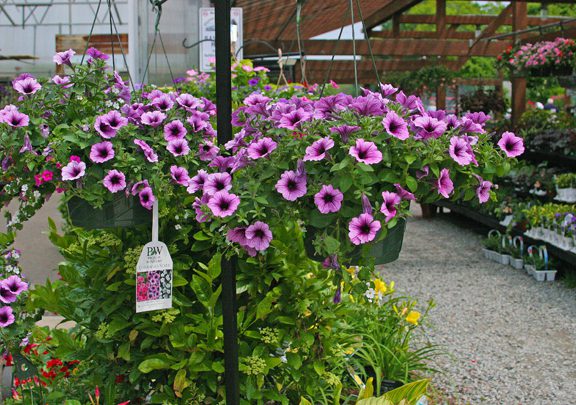Summer Care of Hanging Baskets
Summer Care of Hanging Baskets
A basket of flowers on the front porch, deck or patio is one of the summer’s pleasures. Hanging containers of annuals provide color that brightens all outdoor spaces. They can even add fragrance to your outdoor living areas or attract hummingbirds. But in order to keep your hanging plant looking its best, you need to know how to care for it.
Watering: This is the place where many go wrong by keeping their plants either too wet or too dry. One simple way to learn if your hanger needs water is to lift it from the bottom. Do this a few times right after watering the pot and you’ll learn how heavy the basket feels when it is newly watered. The hanger will feel progressively lighter as it dries out, and once you get accustomed to feeling that it is a lot lighter, you’ll automatically know whether the plants are still wet or if they are getting dry.
You can also stick your finger in the soil and feel if it is drying out. But whatever method you use, be sure to water the basket very well when needed and then wait until it’s getting dry to water again. A through soaking less often is better than a little bit of water every day.
Fertilizing: Hanging baskets come from the garden center well fertilized but you’ll need to keep this up in order for the plants to do well all summer. You can either add some time-release fertilizer to the basket a couple of weeks after you bring it home, or use a liquid feed every two or three weeks. If you’re applying a liquid synthetic fertilizer be sure to water the basket well before you feed. Never fertilize a thirsty plant.
Clipping and Deadheading: Some annuals such as ivy geraniums, Scaevola, and petunias bloom at the ends of their growth. This means that as the summer goes on and the stems of these plants grow longer, all the flowers are at the tips and there is a great deal of green before the blooms start. In order to prevent this from happening you should clip two or three of the stems back every week, preferably starting early before the plant really needs it. Early in the summer you might cut three or four inches off these stems, but later you can cut them back by half or even two-thirds of their length. If you do this every week, you’ll stimulate new, bushier growth and flower production from top to bottom.
Some plants also produce more flowers when they are deadheaded. Geraniums, marguerite daisies and regular petunias are examples of such plants. Cut off the wilted flowers just below the fading bloom as they go by.
Light: Even shade loving plants such as impatiens require some direct sun in order to flower. If your hanging basket is in too much shade it might stop blooming. If this happens, move it to a location that has more light and be sure that you keep up fertilization. If the basket stops flowering on the darker side, be sure to rotate it 180 degrees once a week.
Hanging Basket 911: If your plant has been neglected, gotten too dry or been kept too wet, if it’s still mid-summer it might be possible to resurrect your plants. Cut them back to four to six inches tall, water the basket well and fertilize. If the weather is very hot, move the basket to a location that gets morning light and afternoon shade while it is recovering.

Subscribe To Our Newsletter
Sign up for our weekly email about sales and events.
